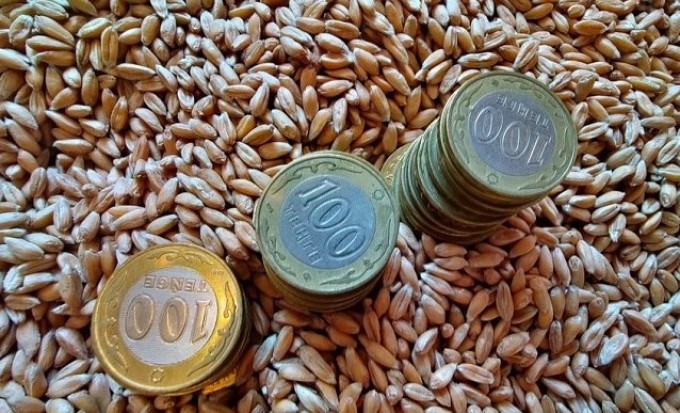
Prices for Hi-Pro wheat (30+ gluten) in Kazakhstan rose to 133,000-137,000 tenge per ton, up 7,000 tenge per ton over the week. Prices for grade 3 wheat with 28-29 gluten increased at a slower pace, reaching 120,000-125,000 tenge per ton, up 3,000 tenge. This was reported by Evgeny Karabanov, Head of the Analytics Department of the Grain Union of Kazakhstan.
According to the expert, prices for grade 3 wheat with 25-26 gluten were 92,000-96,000 tenge per ton (up 1,000 tenge per ton over the week); for grade 27 gluten, prices were 110,000-114,000 tenge per ton (up 2,000 tenge).
At the same time, the price of grade 4 wheat (75,000-78,000 tenge/tonne) and barley (73,000-77,000 tenge/tonne) decreased by 1,000 tenge.
Prices for grade 3 wheat with 23-24 gluten (86,000-90,000 tenge/tonne) and grade 5 wheat (67,000-70,000 tenge/tonne) remained unchanged.
"In the wheat market, demand for high-quality grain remains high, driven by its shortage. Moreover, the higher the quality of the wheat, the higher the price increase. The decline in barley prices is due to continued weak demand from exporters—Iran and China are on hold. A shortage of vessels in the Caspian Sea is driving up freight costs to Iran. Last week, freight costs from Aktau to Iran's northern ports increased further. "Thus, freight rates increased over four weeks by more than 70%, from USD 28 to USD 48 per ton," said Evgeny Karabanov.
According to him, export prices for some wheat varieties, delivered via DAP Saryagash, increased:
Hi-Pro wheat increased by USD 1 per ton to USD 284-288 per ton;
Grade 3 wheat with 27 gluten and 28-29 gluten increased by USD 2 per ton to USD 252-257 and USD 272-277 per ton, respectively. Unchanged export prices for Class 3 wheat with 23-24 gluten content (USD 205-210/t) and Class 25-26 gluten content (USD 210-215/t), as well as Class 4 (USD 185-190/t) and Class 5 (USD 175-180/t) wheat remained unchanged.
Barley export prices decreased by USD 1/t at FOB Aktau (USD 197-201/t); by USD 2/t at DAP Saryagash (USD 178-183/t) and DAP Dostyk/Altynkol (USD 185-190/t).
"The reasons include weak demand from Iran and China, and higher railway tariffs and freight rates." "Furthermore, due to a large backlog of railcars in Aktau due to a shortage of vessels, the conventional ban previously imposed by KTZ from October 6 to 10 has been extended until October 20. In the Dostyk/Alashankou direction to China, due to a large backlog of railcars and poor haircuts on the Chinese side, a conventional ban on loading covered railcars with grain cargo has also been imposed from October 11 to 17," explained Evgeny Karabanov.
He also noted that the weather last week in most regions of the country facilitated harvesting. However, by the end of the week, the weather cooled, with rain in places, and snow in the Pavlodar region. Snow also fell in Siberia, in the Omsk and Novosibirsk regions and in the Altai Krai. This week, forecasters predict cool weather with partly cloudy skies and light rain and snow at the end of the week in the northern regions of Kazakhstan. Daytime temperatures will range from +3 to +11°C, with nighttime temperatures of -8 to +2°C. Weather conditions will be favorable for harvesting grain and oilseed crops.
According to the Ministry of Agriculture's latest data as of October 13, 15.1 million hectares, or 94.1% of the total grain and legume area (over 16 million hectares), have been harvested in the country. 24.6 million tons of grain have been harvested. 2.7 million tons of oilseeds have also been harvested.
"Wheat quality is not improving—the share of grades 4 and 5 wheat is increasing even more," said Evgeny Karabanov, noting that the shortage of high-quality wheat is increasing demand in both domestic and foreign markets.
Furthermore, due to rising logistics costs and a shortage of high-quality wheat in foreign markets, prices for high-quality wheat continue to rise.